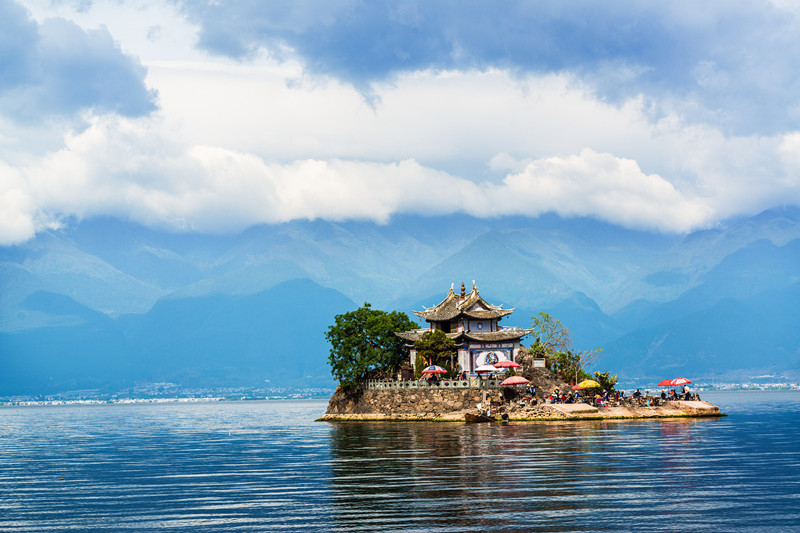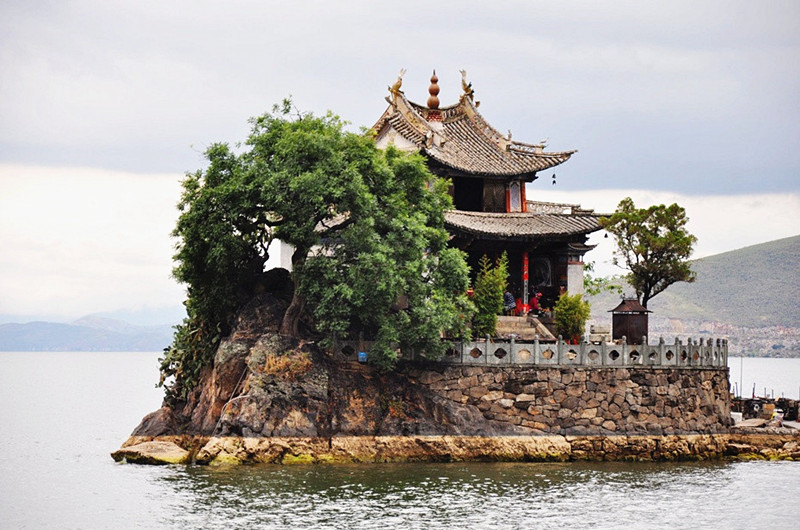
XiaoPutuo Island of Erhai Lake in Dali
Xiao Putuo Island (小普陀岛) is situated on the eastern side of Erhai Lake (洱海) in Dali (大理市), Yunnan Province (云南省). Located at coordinates 25°42′23″N 100°14′05″E, this limestone island covers an area of approximately 100 square meters and rises 12 meters above the water surface. The island is said to resemble a golden seal floating on the water, believed to be the seal used by Avalokiteshvara (观音大士) to calm the sea in ancient times. Its shape and the surrounding pavilions remind one of the legendary Putuo Mountain (普陀山) in Chinese mythology, thus earning its name.
The pavilions on the island were built during the Ming Dynasty (明朝) and consist of two stories. The first floor features a statue of the Buddha (如来), while the second floor houses a statue of Avalokiteshvara (观音). The architecture is charming and intricate, shrouded in mist and imbued with a sense of serenity. Although the island is not large, it is dotted with unique rock formations and lush trees, creating a natural bonsai landscape.

Key Details
- Chinese Name: 小普陀岛 (Xiao Putuo Dao)
- Location: Dali (大理市), Erhai Lake (洱海) eastern side
- Area: 100 m²
- Type: Limestone island
History of Xiao Putuo Island
Origin
Xiao Putuo Island is often referred to as a “miniature island.” Despite its small size, it is quite famous and frequently appears in brochures introducing Dali. The island has a circumference of only 200 meters and is entirely made of limestone. Its shape resembles a round seal, leading to another name, Haiyin (海印). According to legend, the waters of Erhai are home to many dragons that often stir up storms. The rock formation is believed to be the great seal used by Avalokiteshvara to subdue the dragons.
During the Ming Dynasty, around the time of the Chongzhen Emperor (崇祯), local fishermen funded the construction of a two-story pavilion on Xiao Putuo Island to house a statue of Avalokiteshvara, leading to its local name, Guanyin Pavilion (观音阁).
Haiyin Village (海印村)
Located to the east of Xiao Putuo Island, near the natural fishing harbor called Baishi Qu (白石曲), Haiyin Village has developed around it. The village is nestled between Qigupeng (旗鼓峰) of Yuyan Mountain (玉案山) to the east and Erhai Lake to the west. With a population of over 400 households and nearly 2,000 residents, all belonging to the Bai ethnic group (白族), the village maintains rich Bai cultural traditions.
Haiyin Village has around 60 acres of arable land, and residents primarily engage in transportation, selling building materials, and fishing, with an annual catch close to 1,000 tons. The villagers, who are skilled swimmers, can easily reach Xiao Putuo Island in a few minutes. In the past, local fishermen mostly used sailboats or “mule boats” (用浆划的骡子船) for transportation. Haiyin Village exemplifies a traditional fishing village with Bai-style houses featuring white walls and blue tiles. During festive occasions, Xiao Putuo Island becomes a favored site for villagers to worship deities and enjoy leisure activities.

Cultural Significance
Name Meaning
The name “Putuo” (普陀) is derived from the Sanskrit word “Putuo Lujia Mountain” (普陀珞伽山), meaning “Small White Flower Mountain” or “Small Flower Tree Mountain,” believed to be a place where Avalokiteshvara practiced in India. As a result, many places associated with Avalokiteshvara are referred to as Putuo Mountain, such as the well-known Putuo Mountain in Zhejiang Province (浙江普陀山), one of China’s four sacred Buddhist mountains.
The Buddhism practiced in Dali has a notable characteristic of closeness to Bodhisattvas, particularly Avalokiteshvara, more than to the Buddha (释迦牟尼). The Bai people predominantly worship Avalokiteshvara in temples, where she is represented in both male and female forms. Xiao Putuo Island specifically features a female representation of Avalokiteshvara, contrasting with the Theravada Buddhism practiced in regions like Xishuangbanna (西双版纳) and Dehong (德宏).
Xiao Putuo Island is not only a picturesque spot but also a rich center of Buddhist culture.
How to Get There
- By Boat: Visitors can take a boat from Dali city center to Xiao Putuo Island, which is a scenic ride across Erhai Lake.
- Walking: If you are near Haiyin Village, you can easily swim or use a small boat to reach the island.
Travel Tips
- Best Time to Visit: Spring and autumn are ideal for enjoying the pleasant weather and vibrant scenery.
- Photography: Don’t forget your camera to capture the stunning landscapes and cultural architecture.
- Local Cuisine: Explore nearby restaurants in Haiyin Village for authentic Bai cuisine after visiting the island.
- Cultural Etiquette: Be respectful of the local traditions and the peaceful environment when visiting the island.

 7 Days GolfingTour
7 Days GolfingTour
 8 Days Group Tour
8 Days Group Tour
 8 Days Yunnan Tour
8 Days Yunnan Tour
 7 Days Shangri La Hiking
7 Days Shangri La Hiking
 11 Days Yunnan Tour
11 Days Yunnan Tour
 6 Days Yuanyang Terraces
6 Days Yuanyang Terraces
 11 Days Yunnan Tour
11 Days Yunnan Tour
 8 Days South Yunnan
8 Days South Yunnan
 7 Days Tea Tour
7 Days Tea Tour
 8 Days Muslim Tour
8 Days Muslim Tour
 12 Days Self-Driving
12 Days Self-Driving
 4 Days Haba Climbing
4 Days Haba Climbing
 Tiger Leaping Gorge
Tiger Leaping Gorge
 Stone Forest
Stone Forest
 Yunnan-Tibet
Yunnan-Tibet
 Hani Rice Terraces
Hani Rice Terraces
 Kunming
Kunming
 Lijiang
Lijiang
 Shangri-la
Shangri-la
 Dali
Dali
 XishuangBanna
XishuangBanna
 Honghe
Honghe
 Kunming
Kunming
 Lijiang
Lijiang
 Shangri-la
Shangri-la
 Yuanyang Rice Terraces
Yuanyang Rice Terraces
 Nujiang
Nujiang
 XishuangBanna
XishuangBanna
 Spring City Golf
Spring City Golf
 Snow Mountain Golf
Snow Mountain Golf
 Stone Mountain Golf
Stone Mountain Golf















